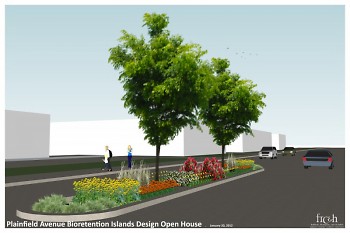A one-mile stretch of Plainfield Avenue from Leonard to Ann Street is about to undergo a major makeover with the construction of seven bio-retention islands in the median.
A bio-retention island is a type of infrastructure that uses plants, trees and underground basins to retain stormwater and use the water to maintain the plant life. The islands will reduce the amount of stormwater that goes into the city sewer system by redirecting stormwater runoff into basins. The basins located on the sides of the street will direct the water underneath the street into the islands.
“The rain will start in the roadway and flow to the curb lines; it’s sort of a first flush type of system. So anything that’s in those gutters will be captured,” said Breese Stam, senior project engineer for the city of Grand Rapids.
After the gutter, the water will flow into catch basins where heavy metals, solids and grease are removed, said Stam. This water, which otherwise would carry bio-contaminants such as oil, gasoline and road salt into the Grand River, will be pumped into the basins and used to hydrate the plants with self-maintaining technology.
For four years, the Creston Neighborhood Association has been working on plans to beautify the neighborhood with foliage, then neighborhood leaders heard that Plainfield Avenue, its main business district, was going to be resurfaced.
“In terms of our ability to really push hard…it happened the way it happened because we had already been engaging in this conversation for four years prior to them telling us they were going to resurface the road,” said Deborah Eid, executive director of the Creston Neighborhood Association. “The city loved the idea but there was no money for roads.”
After brainstorming with the city about where they could find funding for the project, stormwater management entered the discussion. Michigan’s Department of Transportation was very interested in this aspect of the development.
“They essentially are looking for all kinds of ways to get that storm water to do something other than flow out into the big lake,” said Eid. “The more you put in the more storm water you can capture, but there are costs and other variables that have limited us to the number seven.”
This project was largely funded by a $146,667 grant from MDOT, in addition to donations from the city of Grand Rapids, the Dyer Ives Foundation, the Community Foundation, the Meijer Corporation and Foundation and over $89,000 from Creston business owners who were hopeful about the project’s effect on the neighborhood.
“The way they’re giving that amount of money is a plan where the gifts are distributed for 10 years which, allows them to commit to giving more,” said Eid.
This deferred plan, which was set in motion by the city, accelerated the fundraising efforts and solidified the city’s and Creston’s commitment to the $305,000 project. The fundraising also encompasses the maintenance costs for the islands.
“We have set aside a $30,000 endowment fund and that was a part of our fundraising," said Eid. "We were asked by the city to invite people to give to that endowment fund as well as the actual construction costs. It will be there and available for 20 years of maintenance.”
With an increase in green space, the Creston neighborhood will also see a reduction of pollution and net carbon emissions from the islands, said Eid. The trees and plants will absorb gases such as carbon dioxide and replenish the air with fresh oxygen. The plants were chosen for their particular resiliency in urban settings. Elise Tripp, landscape designer for Fishbeck, Thompson, Carr & Huber, Inc., selected the plants based on several factors.
"I wanted plants that would bloom for as long as possible and had year round interest," said Tripp. "[Plants] that would hold up well. I needed tough plants, ones that could handle being in the middle of the road, where it can be hot and dry at times.”
The design will include trees such as the Accolade Elm and Goldenraintree, known for their resiliency and ability to retain water. An assortment of shrubs, grasses and perennials will also be featured with a plethora of bright colors to liven up the area.
“There should be something blooming anytime you go by the islands late spring into fall and in the winter too there will still be some interesting berries and different things that will still be visible,” said Tripp.
The islands located in front of Creston High School will primarily showcase blues and yellows representing the school’s colors. Driving lanes on Plainfield will be further away from each other and separated by the islands. Planners hope that this green initiative will attract new business and help the current businesses thrive.
“We’re hoping this is going to be the start of re-energizing this end of town,” said Eid.
The construction is set to be finished in August.
The Rapidian, a program of the 501(c)3 nonprofit Community Media Center, relies on the community’s support to help cover the cost of training reporters and publishing content.
We need your help.
If each of our readers and content creators who values this community platform help support its creation and maintenance, The Rapidian can continue to educate and facilitate a conversation around issues for years to come.
Please support The Rapidian and make a contribution today.

